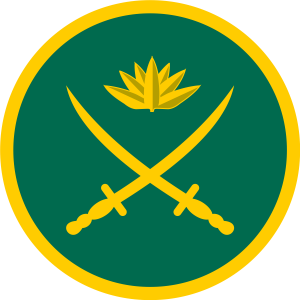
The Bangladesh Army (Bengali: বাংলাদেশ সেনাবাহিনী, Bangladesh Senabahini) is the land warfare branch, and the largest of the three armed services Bangladesh Armed Forces. The primary mission of the Army is to provide necessary forces and capabilities
to deliver the Bangladeshi government's security and defence strategies, such as, and most notably, defending the nation's territorial integrity against external attack. Control of personnel and operations is administered
by the Department of the Army, Armed Forces Division. In addition to its primary mission the Bangladesh Army is also constitutionally obligated to assist the government and its civilian agencies during times of
domestic national emergency. This additional role is commonly referred to as "aid to civil administration".
History:
The martial tradition of Bengal has its roots in the army of Kings and their chiefs who were called Senapati or Mahasenapati. Armies were composed
of infantry, cavalry, war elephants and war boats. The arrival of Muslims and the establishment of the Bengal Sultanate further strengthened the military. The sultanate had well organised disciplined armies. During
Mughal rule Cannons and artillery were introduced to Bengal. During the Colonial Rule of the British, Bengal was principally a bulwark of British power and trade in the South Asian region. The British under Robert
Clive defeated a 50,000 strong Bengal Army of Nawab Siraj-ud-daullah in the Polashey(Plassey) in 1757 and later the forces of Nawab Mir Qasim at the Battle of Buxar in 1764. The Army of Bengal was formed, which
later became part of a united Indian Army from 1895 to 1947. The eastern part of the British India was a prominent place for military and police recruitment, with entire horse-mounted cavalry and lancer units being
recruited there prior to the Bengal Sepoy Mutiny of 1857. Post-mutiny, units with the epithet "Bengal" in their name, such as Bengal Sappers and Bengal Cavalry, were largely recruited from non-Bengali peoples from
Bihar, Varanasi and Uttar Pradesh which were technically still part of Bengal Presidency at that time. During the First World War, the Bangali Paltan was formed to recruit soldiers from Bengal. In 1916, the British
Government created Bengali Double Company. The soldiers were trained in Karachi and shipped to the Bagdad. They fought in the war and after the war helped crush a rebellion by Kurds in 1919.
Administrative branches:
Bangladesh Army is divided into the following administrative Corps:
-
Combat Arms
- Armoured Corps
- Regiment of Artillery
- Infantry
- Para-Commando Brigade (Bangladesh Army)